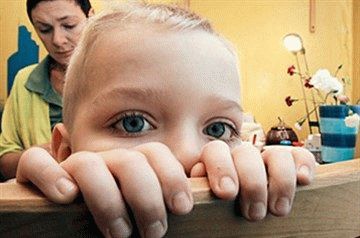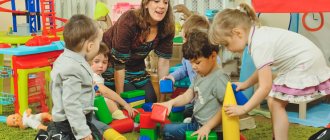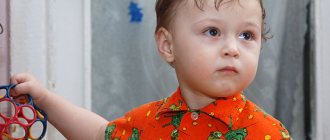The decision to accept a child into a family is quite difficult, because it is necessary to have certain qualities and boundless love and care. Even after making such a decision, potential mothers and fathers face difficulties. On the agenda is the question of what a child should be like: a boy or a girl, age, even appearance plays a role. This stage is the most difficult for future parents, and, as a rule, resolving this issue takes a lot of time.
In fact, most adoptive parents or guardians want to take under their wing a child with a pleasant appearance, of a young age; the state of health plays a huge role - the child must be healthy. Few guardians are ready to take responsibility and adopt a child with disabilities, defects in appearance, or a child with serious illnesses. As a result, adoptive parents are faced with some problems; such “ideal” ideas have to be abandoned and faced with harsh reality.
In order to accept a healthy child, you still need to find him - spend a lot of time and nerves visiting the appropriate institutions. According to the data, among the “refuseniks” there are actually very few children with impeccable health, there are many reasons for this, but this is a separate conversation.
Psychologists do not advise setting strict criteria for yourself when choosing a child - it must be a girl, blonde hair and impeccable health - no. There are many cases when parents with worked out criteria, after visiting a child care facility and communicating with the kids, abandoned the original plan and adopted a completely different child. There is also a violation of plans for the adoption of a number of children. Sometimes, adoptive parents, having learned that their baby has a brother or sister, decide to accept a second child into the family.
Gender and age of the child for adoption or guardianship
When choosing a gender, it is worth remembering that finding a boy is a little easier than finding a girl in the state guardianship authorities, there are no exact explanations for this, it’s just how it happened historically. It is worth remembering that children develop more slowly in the system, and therefore there is no need to set clear age limits. It is likely that a four year old will look like a three year old. It is best to keep in mind the age of the baby, but do not refuse to meet older or younger children.
If it was decided to take a preschooler into the family, then he needs time to adapt. If you take a six-year-old child in August and send him to school in September, problems will arise, both for the parents and for the child himself. Therefore, it is necessary to take time into account and give the child the opportunity to adapt. Ideally, you need to leave the child at home for a year, and let the guardians not be afraid that the child will go to first grade a year later, this is much easier than an unadapted child in the family, and even at school it is necessary to adapt.
Child status
There are two types of status for a child in orphanages. Some kids can be taken under any form of guardianship - adoption, foster care, guardianship, etc., while other kids can only be taken under guardianship. If you decide to immediately adopt a child, you need to look for a child with full status.
But there is another side to the coin; there are situations when the child practically has a status, but for its realization it is necessary to wait some time. In fact, this is far from a bad situation, because it is possible to take the child under guardianship “to get used to each other,” and only then adopt.
A child may not have full status for several reasons, for example, the child’s parents are in prison, in which case deprivation of parental rights is not possible. The child’s parents may be given a restriction of rights based on “behavior”; such a restriction is imposed for six months, and after this time the issue of either depriving them of their rights completely or returning the child to the family is decided.
Status may also be absent due to mental disorders in the child’s parents. It is possible to completely deprive such parents of parental rights only if their incapacity is recognized and a guardian is appointed. But, on the other hand, such parents will not be able to take the child. The calmest option is considered to be the absence of the necessary time - six months, which must pass after the parents are deprived of their rights. This option does not require any additional procedures.
Other materials on the topic
- The beginning of the school year: how to survive and what parents should not forget. Advice from psychologist Lyudmila Petranovskaya
- School of surrogate parents
- "Children's Project" helped organize a holiday for foster families
- "Opora" - a club for foster parents
- Communication. When and how does a child learn to communicate? What mistakes do adults make when communicating with children? Video with transcript
- The “Key” to solving orphan problems was found in Ryazan
- 7 risks of foster care: why children are returned to orphanages
- You don't have to be perfect to be a perfect parent. Smart social advertising. Part 1
Health status of the child for adoption or guardianship
Taking into account the lifestyle of parents who left their babies, it is not very correct to look for a baby with a complete absence of diagnoses - this is at the level of fantasy. There are practically no healthy babies; most often you can find babies without serious pathologies.
Before you start searching for a child, you need to decide what diagnoses are preventing your child from being accepted into a family. The most common fears are HIV, hepatitis, Down syndrome, cerebral palsy, mental retardation, autism, etc. But it is necessary to study at least a little about a serious diagnosis and understand the differences in medical terms. Usually, when parents see the abbreviation HIV, they immediately refuse, and it doesn’t matter in what context the diagnosis is. “HIV” and “HIV contact” are completely different things.
The same applies to aesthetic disorders of the child’s appearance, for example, ptosis/strabismus, but the child does not look the best, and this pathology is striking. But strabismus can be successfully treated with conservative methods, but ptosis can be treated no less successfully, but still surgically.
The hereditary factor is an important criterion that also needs to be determined. Is it possible to take risks, and is there a willingness to take this risk, if it is known for certain that the disease occurs in 25–30% of cases. It is especially difficult to make a choice if there is a heredity that relates to psychiatric diseases. Doctors say that it is possible to talk about heredity in psychiatry if it is known that other relatives also have the diagnosis. If we are talking about an acquired psychiatric diagnosis - alcoholic psychosis, this disease is not inherited.
It is worth remembering that the confirmed alcohol or drug addiction of biological parents significantly affects the physical health and intelligence of the child. Most often this is expressed in increased excitability of the child, and such children are diagnosed with hyperactivity syndrome. If the adoptive family is accustomed to silence and a measured lifestyle, then you should think carefully, because the baby will be very active, athletic and inquisitive, sometimes even too much.
It is the assessment of the child’s health status that should take the leading place, because it is necessary to soberly and sensibly assess whether it will be possible to carry out adequate treatment and rehabilitation of the child.
Child's relatives
It is necessary to immediately discuss the attitude towards the child’s blood relatives, most often these are grandmothers, aunts, etc. if the child is immediately adopted, then this issue does not need to be discussed, since there is a secret of adoption, the relatives simply will not know which family he is in child.
But if the child is under guardianship or in a foster family, then relatives have the right to communicate. As practice shows, most often this remains at the level of desire, or it can be phone calls to make sure that everything is okay with the child.
If communication with the child’s relatives causes harm to the child, then guardians or adoptive parents have the right to limit this communication by obtaining the opinion of a psychologist and writing an appropriate statement.
Who can apply to be an adoptive parent?
Articles on the topic (click to view)
- What to do legally if a mother does not pay child support
- Legal assistance to orphans
- Federal Law 159 on additional guarantees for social support for orphans
- Fixed child support under the new law of 2021 if the father works
- Form of agreement on payment of alimony for a minor child: sample 2021
- Conditions and documents for obtaining a plot of land for a third child in 2021 in Moscow
- Conditions for receiving and amount of maternity capital for a second child after 2021
There is an opinion that only a couple who is officially married can adopt a child. However, in reality the situation turns out to be different.
Article 127 of the Family Code of the Russian Federation determines that adult persons can be adoptive parents, regardless of their gender. Candidates must have good characteristics and a stable living situation. Any adult citizen with good health, financial stability, and his own home can claim to be a parent.
Who can't adopt a child?
The following categories of citizens of the Russian Federation cannot be adoptive parents:
- People who have been declared incompetent or partially capable. If the candidate is a family, both partners must be legally capable;
- Inconsistency in the age difference between the child and the adoptive parent;
- Persons with a criminal conviction;
- Citizens who were adoptive parents or guardians and were removed for failure to fulfill obligations;
- People who failed as parents, guardians or adoptive parents due to insufficient child care or serious violations in the performance of obligations;
The right of an adopted child to inheritance.
What is the difference between a foster family and guardianship, read here.
- Citizens who are unable to provide an optimal standard of living for their child;
- People without permanent housing;
- People with serious medical conditions that prevent them from successfully performing all parenting responsibilities;
- People living in apartments that do not meet sanitary standards.
Thus, Russian legislation provides for restrictions on the identities of potential parents. It is mandatory to check the living conditions and personal qualities of potential adoptive parents. For verification, documents are used that confirm certain character traits and aspects of worldview.
Appearance of a child for adoption or guardianship
This question will be relevant only after 2 years, newborn babies can change dramatically by the age of one year, turning from blond to brunette or vice versa. Only the eye color remains unchanged after six months of a child’s life. If it has been decided to maintain a conditional secret, and the adoptive parents are afraid of the questions: “Who is your baby like?”, then it is worth remembering that genetics is a mysterious “thing.” With a clear conscience we can say that the child looks like his grandfather, grandmother, etc. Even children from mixed-race parents can have a completely Slavic appearance and vice versa.
Necessary documents for adopting a child
After the choice is made, you can go to court with a special statement confirming your interest in carrying out the adoption procedure. Representation of guardianship in resolving the issue becomes mandatory.
Adoption of a baby is possible only if you have the following documents:
- Standard employment certificate, revealing the specifics of the financial condition and the availability of a certain position;
- Health certificate of the intended parents;
- A document confirming no criminal record;
- Housing documentation that confirms optimal conditions for the child and the availability of property rights;
- Written consent of the husband or wife to adopt a child, if the procedure is carried out by only one partner in the family;
- A copy of the marriage certificate, if the child is being adopted by a full-fledged married couple;
- Personal description from the workplace;
- Documentary confirmation of payment for housing and communal services;
- Autobiography;
- Original and copy of passport. The original document is only shown when contacting the relevant organization.
The collected package of documents is accompanied by the consent of the administration of the children's institution to carry out the adoption procedure.
If the child is 10 years old, the court takes into account the child’s wishes.
If the decision is positive, you need to wait until you can take the child home. After this, the information in the documents about the minor is changed. To correct documents, you are supposed to contact the registry office.
The criteria are clear
After realizing and understanding what kind of child the family wants to adopt - gender, age, external qualities. It is necessary to start searching for the baby. First of all, the guardianship authorities will offer to get to know the children who are in the guardianship area. But if there are no suitable children in the area of residence, or there are simply no child care facilities, then in the future you need to start searching on your own. And here, there is a direct proportionality: the more effort and time spent searching for the baby, the more successful the result will be.
You should not start with telephone calls to the guardianship authorities; the ideal and correct option is to collect all documents and opinions. And as soon as they appear in the guardianship authorities, you can storm the telephone lines.
If a family wants to accept a newborn baby into their family, then there is no point in calling the guardianship authorities. Information about such children arrives three months later, or even later, after refusal - that’s the system. The ideal and correct option is to obtain information about which medical institution the refuseniks are admitted to. Visit all wards on whose territory there are hospitals with incoming refuseniks and register everywhere. Some regions do not release babies from hospitals, but wait until they are transferred to orphanages, and in such institutions it is also necessary to register.
If it was decided to adopt a non-newborn baby, then immediately after receiving the conclusion, you must make an appointment with the regional guardianship authorities. Upon arrival on the reception day, you must provide all documents and a statement of desire to familiarize yourself with the profiles of the children assigned to the territory of guardianship. If there are babies that potential parents are interested in, you need to get a referral to meet the child.
Where to look for children for adoption?
Once we have a positive decision from the guardianship authorities, the most exciting thing begins - the search for orphans for adoption. Guardianship authorities can help with this.
There is also a system where children are found for adoption - the Federal Data Bank. Information in this system is collected first at the local level, then at the regional, and then at the state level.
If you cannot find your baby in the Data Bank, you can personally contact the following institutions:
- preschool orphanages that house children up to seven years old for adoption;
- orphanages - they house orphans for adoption who have reached school age;
- orphanages or maternity centers – they house children for adoption who are deprived of parental care.
All of the above institutions are quite closed. And employees do not have the right to disseminate information about children. However, managers can tell you where to go.
Visiting orphanages

Children from an orphanage for adoption are the most common option.
Information about children from the orphanage can be found in the official database.
The database for adoptive parents opens after the guardianship authorities have issued a positive conclusion.
This database contains children who are waiting for adoption, their photographs, brief information, and the status of children in orphanages throughout the country. As soon as you have found a suitable child, you need to contact the local guardianship authority and get permission to meet him, without which you will not be allowed into the orphanage.
The permit is valid for ten days. On these days, you will need to meet with the child and get acquainted with his personal file and medical record. The orphanage staff will talk about the character and life of the baby. If, after visiting the child, you feel that he is not suitable for you, you need to fill out the appropriate paper about the results of the meeting, and you can start the search again.
Adoption of abandoned children or children from an orphanage

Most often, a baby ends up in a baby home after his mother abandoned him in the maternity hospital for one reason or another.
And there are a lot of people who want to adopt a very small child, since it is easier to raise children from infancy.
Adopting a baby from a maternity hospital is extremely difficult, since after the mother’s refusal, it takes time to complete all the necessary documents.
From the maternity hospital, the newborn goes to the children's department, where he will undergo a medical examination. Then he is transferred to an orphanage, from where he can be taken.
After receiving the adoption permit, you must get in line and wait. After the turn comes, it will be possible to get acquainted with the Data Bank of the babies in the orphanage, or a signal will be received from the operator.
Database
A data bank is a system for collecting, storing, and systematizing information about children who were left without parental care. After the birth of the child, employees of the guardianship authorities fill out a questionnaire (photo of the child, personal data, status, medical indications, information about the parents). If children who can be adopted within 30 days do not find a family, their profiles are placed in the Federal Data Bank.
To view children’s profiles, you need to contact the Data Bank operator with the following documents:
- an application requesting information about children, where you need to indicate search criteria;
- candidate adoptive parent data form.
This is important to know: What is the percentage of child support for the first child?
The Database employee will provide existing profiles of children that match the request parameters.
Typically, the employee provides information on the day of the request, but in some cases the data is provided no later than ten days. If there are currently no suitable candidates for adoption in the Data Bank, you will have to wait. As soon as a suitable child becomes available, a Bank employee will contact you.
Friends or relatives

Adoption of a child by a relative or friend is possible only if both parents have died or been deprived of parental rights.
If this is the case, then the adoption process follows the same procedure as for all other children: first contact the guardianship authority, then go to court.
Dear readers! Our articles talk about typical ways to resolve legal issues, but each case is unique.
If you want to find out how to solve your particular problem, please use the online consultant form on the right or call:
It's fast and free!
Studying questionnaires of children for adoption or guardianship
The questionnaire and the child himself are in the vast majority of cases different. Even a photo of a child may not correspond to reality, sometimes even the diagnoses in the questionnaire do not correspond to the truth, so you should be more careful in your choice and check everything yourself. To make the task easier, you can focus on the child’s health group: group 1 – absolutely healthy, groups 2 – 3, children with mild treatable pathologies, group 4 – the presence of chronic diseases, and children with health group 5 have disabilities. Only the attending physician has accurate information about the child’s health status, and the diagnoses written in the questionnaire are transmitted after the next medical examination, and the human factor should not be excluded.
From all of the above it follows: if you like the child, but there are concerns about his health, then it is best to take a referral and get acquainted with his medical history in detail, on an individual basis, thereby eliminating all possible mistakes.
How can a single woman adopt a child?
Single women can also go through the procedure of adopting a child in order not to feel abandoned. However, you need to understand that representatives of the guardianship authorities will check the following aspects with particular responsibility:
- Financial condition and availability of a stable income;
- Availability of assistants in raising a child;
- Possibility of insurance in case of force majeure (for example, illness followed by hospitalization, the need to go on a business trip);
- Possible change in the status of a single mother (if a woman plans to get married).
This is important to know: Conditions and documents for obtaining a plot of land for a third child in 2021 in Moscow
It is important to be prepared for frequent and comprehensive inspections by guardianship authorities and other specialized institutions. A single woman should be prepared for the need to resolve numerous issues.
You should not think that the guardianship authorities will be biased towards single mothers. Guardianship workers try to control the child’s fate in order to have the opportunity to note the manifestation of care and love, the presence of good income.
Conversation with guardianship
Initially, you need to familiarize yourself with the child’s personal file and find out at what age the child entered the institution, who his biological parents are, the results of the latest medical examinations, the presence of possible relatives, etc. Again, you should trust only those personal data that are documented.
After studying the questionnaire, before meeting the baby, the child care facility gives potential parents the opportunity to study the child’s medical record, and they will not hide the baby’s diagnoses from the parents, rather the opposite!
The ideal option is the help of a doctor who will help decipher incomprehensible medical terms, abbreviations, etc. It would not be superfluous to study “typical diagnoses of children in the system.”
A consultation with the pediatrician assigned to the children's institution is necessary; it is necessary to find out what the main diagnosis is, what studies were carried out and what the results are over time. Potential parents have every right to an independent medical examination of the child.
It is worth remembering that children in the system lag behind their peers raised in the family, and this, in most cases, is not a developmental delay, but simply neglect of the child. It’s just that kids don’t have enough parental attention, and there’s no one to try for!









